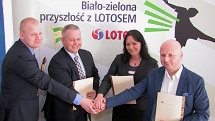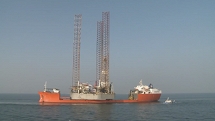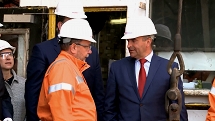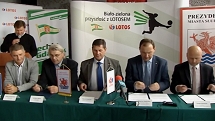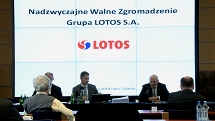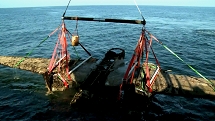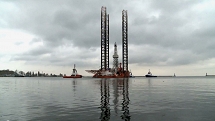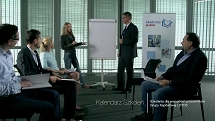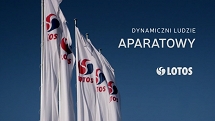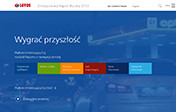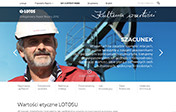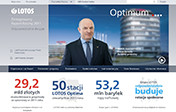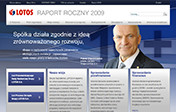-
Financial information
The past year ushered in a series of challenges for the companies in the fuel sector. The decisions made by us have demonstrated that we are able to take rapid steps to adapt to a demanding environment and ensure the desired profitability for our projects.
-
Segment performance
The segmental management model we have implemented enhances management efficiency, delivering cost and revenue synergies across the organization.
-
Letter from the Vice-President of the Board
2014 ushered in a series of challenges for the companies in the fuel sector. The decisions made by the LOTOS Group have demonstrated that we are able to take rapid steps to adapt to a demanding environment and ensure the desired profitability for our projects.
-
Business environment
The key factor that had a strong impact on both the global and Polish petroleum markets in 2014, with significant consequences for the LOTOS Group’s performance, was the price of crude oil, which also determined the price of petroleum products.
-
Strategic objectives
The LOTOS Group’s Strategy is designed to strengthen our position as a strong, innovative and efficient business which plays a major role in ensuring national energy security.
-
Business model
Our operations consist in crude oil production and processing, as well as wholesale and retail sale of petroleum products, among which are: fuels (unleaded gasoline, diesel oil and light fuel oil), heavy fuel oil, bitumens, aviation fuel, naphtha, propane-butane LPG and base oils.
-
Risk and opportunities
At the LOTOS Group, we identify a range of diverse risks, which may affect all areas of our business. The key risks in terms of their impact on our operations are the financial risks as well as risks affecting the exploration and production area. In the analysis of the risks, we also factor in issues related to sustainable development.
-
Key data 2014
With revenue of ca. PLN 28.5bn in 2014, we rank fourth in the group of 500 largest businesses in Poland.

← Statement Notes index
5. Material judgements and estimates
The preparation of financial statements in accordance with the International Financial Reporting Standards requires a number of assumptions, judgements and estimates which affect the value of items disclosed in these financial statements.
Although the assumptions and estimates are based on the management’s best knowledge of the current and future events and developments, the actual results might differ from the estimates.
The estimates and underlying assumptions are reviewed on a continuous basis. Any change in an accounting estimate is recognised in the period in which it was made if it refers exclusively to that period, or in the current period and future periods if it refers to both the current period and future periods. Material assumptions used in making the estimates are described in the relevant notes to these financial statements.
While making assumptions, estimates and judgements, the Company's Management Board (Management Board) relies on its experience and knowledge and may take into consideration opinions, analyses and recommendations issued by independent experts.
The professional judgement of the management, as well as accounting estimates and underlying assumptions, were of key importance in the application of the accounting policies in the cases described below.
Employee benefit obligations
Employee benefit obligations are estimated using actuarial methods. For information on the actuarial assumptions and valuation of employee benefit obligations see Note 29.4.
Depreciation/amortisation
Depreciation/amortisation charges are determined based on the expected useful lives of property, plant and equipment and intangible assets. The Group reviews the useful lives of its assets annually, based on current estimates. The relevant estimate update which had an effect on the Group's financial statements for 2014 chiefly involved a PLN 23,472 thousand decrease in depreciation at the Parent.
Depreciation of the assets of onshore and offshore oil and natural gas extraction facilities is calculated (using the units-of-production depreciation method) based on 2P hydrocarbon reserve estimates (proved and probable reserves), evaluated, revised and updated by the Group, as well as forecast production volumes from the individual oil and gas fields based on geological data, test production, subsequent production data and the schedule of work adopted in the long-term strategy.
Following the purchase of a portfolio of Heimdal assets on the Norwegian Continental Shelf in December 2013, the estimated oil and gas resources increased, which has affected the depreciation/amortisation (with the unit-of-production method) of the Group's production assets since January 1st 2014.
Fair value of financial instruments
Fair value of financial instruments for which no active market exists is measured with the use of appropriate valuation methods. In selecting the methods and assumptions appropriate for these objectives, the Group relies on professional judgement.
For more information on the assumptions adopted for the measurement of fair value of financial instruments, see Note 7.23.
Deferred tax assets
The Group recognises deferred tax assets if it is assumed that taxable income will be generated in the future against which the asset can be utilised. If taxable profit deteriorates in the future, this assumption may prove invalid. The Parent’s Management Board reviews its estimates regarding the likelihood of recovering deferred tax assets taking into account changes in the factors on which such estimates were based, new information and past experience.
For information on deferred tax assets, see Note 10.3.
Impairment of cash-generating units, individual items of property, plant and equipment, and intangible assets
In accordance with IAS 36 Impairment of Assets, as at the end of each reporting period it is assessed whether there are any indicators of impairment of cash-generating units and individual assets. Impairment indicators may be external and may relate to market variables (including fluctuations in prices, FX rates, stock prices, interest rates and other variables related to current economic trends), and may also follow from plans, actions and developments at the Group, such as decisions concerning change, discontinuation, limitation or development of its business, technology changes, or efficiency and investment initiatives.
If there is any indication of impairment, the Group is required to estimate recoverable amounts of assets and cash-generating units. While determining the recoverable amount, the Company takes into account such key variables as discount rates, growth rates and price ratios.
Following an analysis of cash flows for individual cash-generating units and the required impairment tests for assets, the Group made necessary adjustments to assets and presented the effect of those adjustments in these consolidated financial statements.
For information on property, plant and equipment, goodwill and other intangible assets, see Notes 13, 14 and 15, which also describe the assumptions and results of impairment tests of these assets performed by the Group in 2014 and in the comparative period.
For information on impairment of the Group’s investments in joint ventures, see Note 16.
Provision for decommissioning of the upstream segment’s facilities and land reclamation
As at the end of the reporting period, the Group analyses the costs necessary to decommission oil and natural gas extraction facilities and the expenditure to be incurred on future land reclamation. As a result of those analyses, the Group adjusts the value of the land reclamation provision recognised in previous years to reflect the amount of estimated necessary future costs. Any changes in the estimated time value of money are also reflected in the amount of the provision. For information on the rules for recognition of these provisions and information on provisions disclosed in these financial statements for 2014 see Note 7.27.1 and Note 30.1, respectively.
Recognition of revenue from sales of crude oil and natural gas derived from joint operations in Norway
In line with the Group’s accounting policy, revenue from sales of hydrocarbons produced from the fields on the Norwegian Continental Shelf in which the Group holds interests is recognised using the entitlements method (see Note 7.2), in proportion to the Group’s entitlement to production from a given field. Revenue from oil and gas sales disclosed in the statement of comprehensive income for a given reporting period is estimated based on up-to-date data on production from the individual fields in the reporting period. Any differences between the amount of actual revenue from sales of crude oil produced from the Skirne, Vale and Atla fields and the Group’s revenue estimated based on the contractual share of production from the fields are recognised in the statement of financial position under trade receivables and trade payables, which in 2014 amounted to PLN 5,730 thousand and PLN 704 thousand, respectively.
Control of an investee
According to IFRS 10 Consolidated Financial Statements, the Group controls an investee when it is exposed or has rights to variable returns from its involvement with the investee and has the ability to affect those returns through its power over the investee. When assessing whether it controls an investee the Group considers all relevant facts and circumstances, including the entity’s purpose and design, its relevant activities and decision-making process, and the significant rights of the investor (excluding protective rights) giving it the current ability to direct the relevant activities, as well as the nature of its relationship with other parties in respect of such entity. The Group reassesses whether it controls an investee if facts and circumstances indicate that there are changes to one or more of the three elements of control: power over the investee, exposure (or rights) to variable returns, and the ability to use its power over the investee. As at the end of the reporting period, the Group controls all of the entities presented in these financial statements as subsidiaries (see Note 2).
Collective control of an investee or operation
The Group and two or more investors collectively control an investee when they must act together to direct the relevant activities. In such cases, because no investor can direct the activities without the cooperation of other investors, no investor individually controls the investee. The Group assesses whether it shares control of an arrangement, which – according to IFRS 11 Joint Arrangements – may be defined either as a joint venture or a joint operation, taking into consideration whether all parties to the relevant arrangement have control of it, whether they share exposure, or rights, to variable returns from their involvement with the investee, and whether they have the ability to jointly use their power over the investee to affect the amount of their returns. As at the end of the reporting period, the Group was involved in joint operations under projects carried out in Norway, and was involved in joint ventures (see Note 2 and Note 16), of which, considering all facts and circumstances, it had shared control.
The Notes to the consolidated financial statements are an integral part of the statements.
(This is a translation of a document originally issued in Polish)






